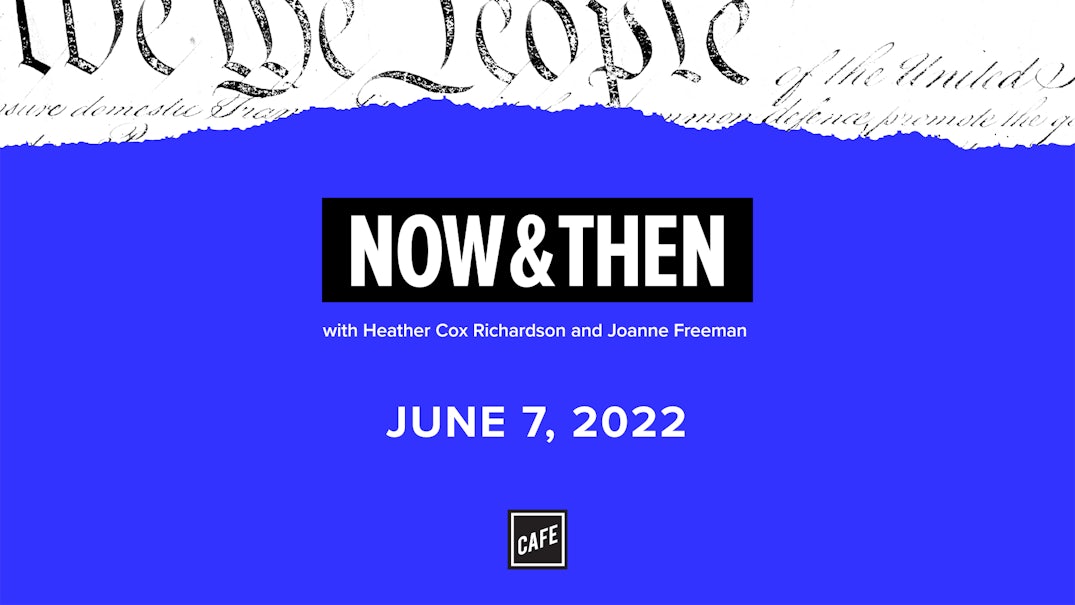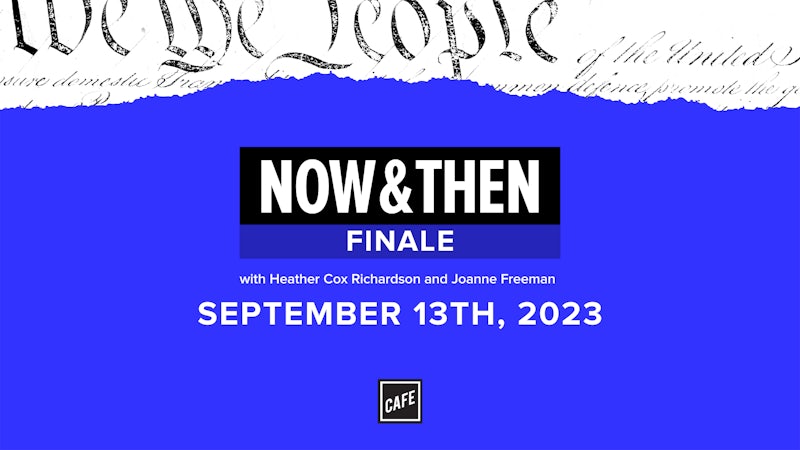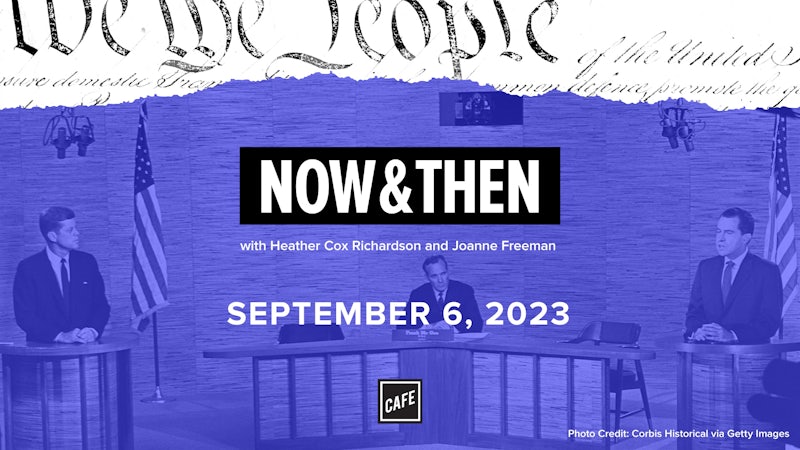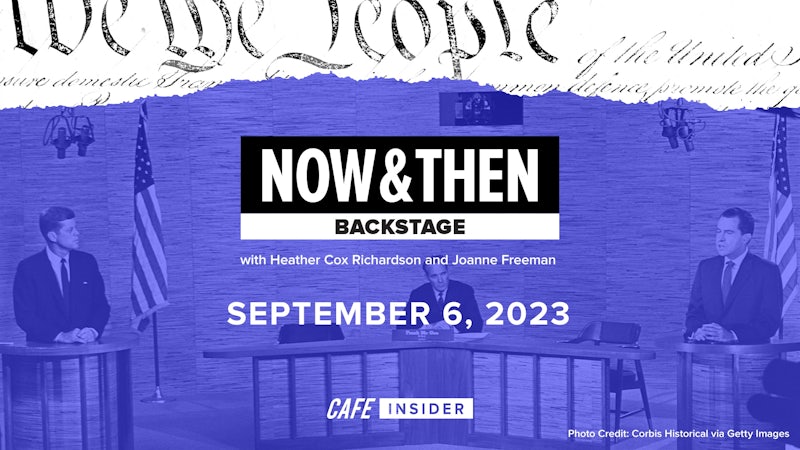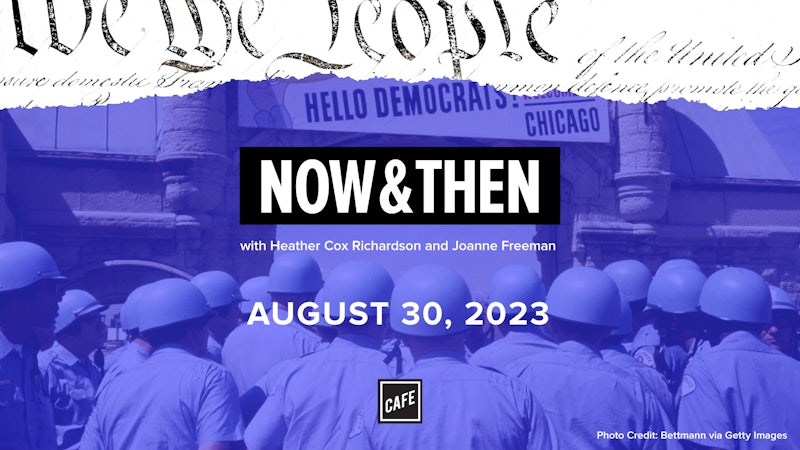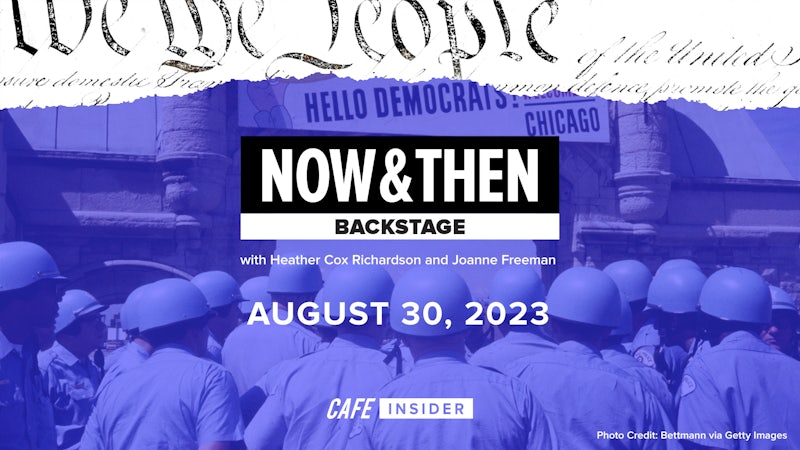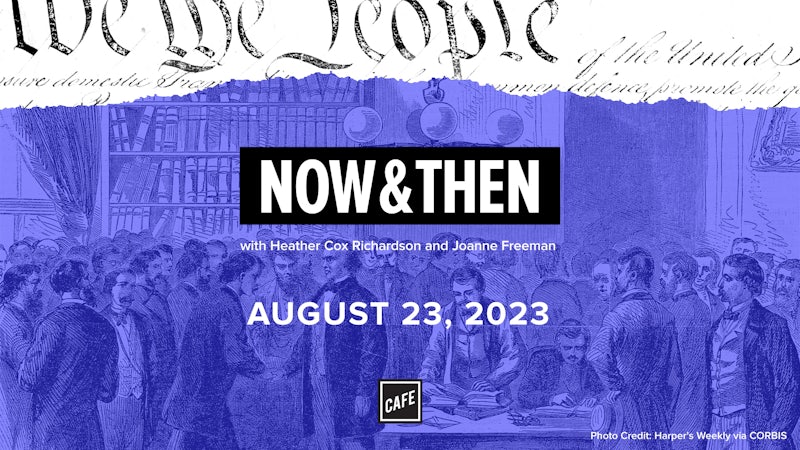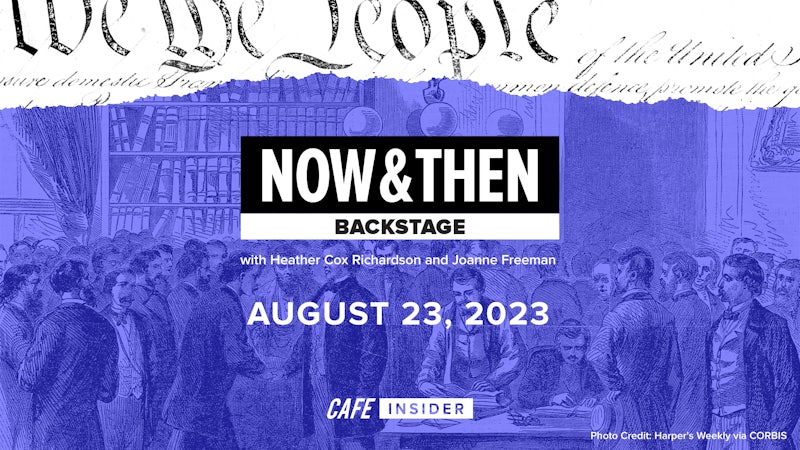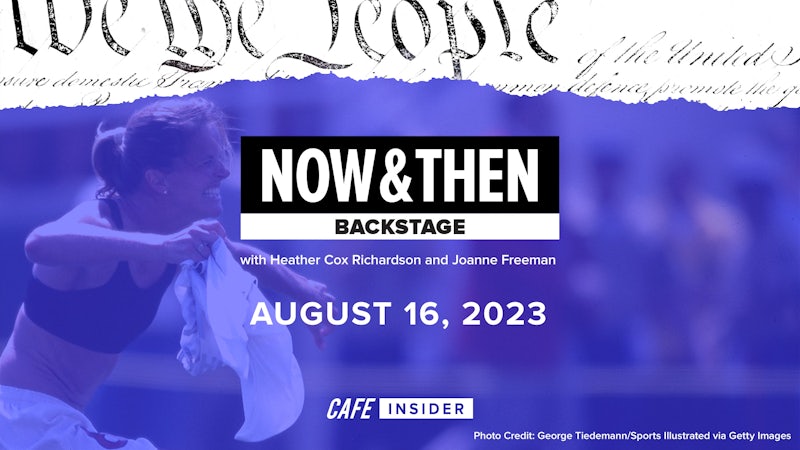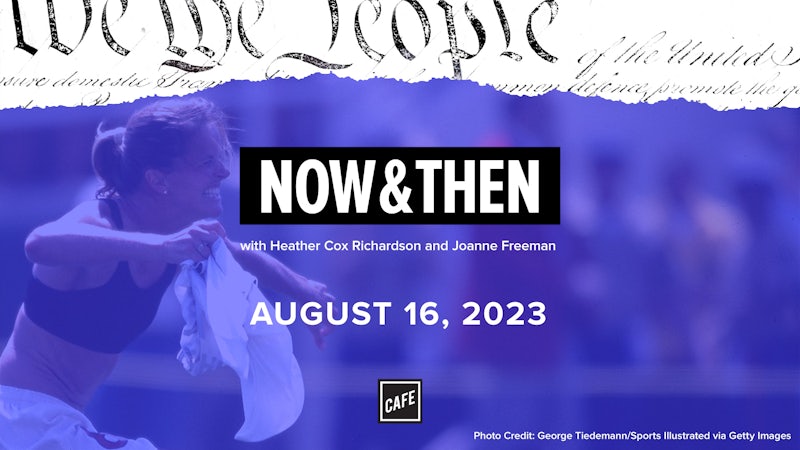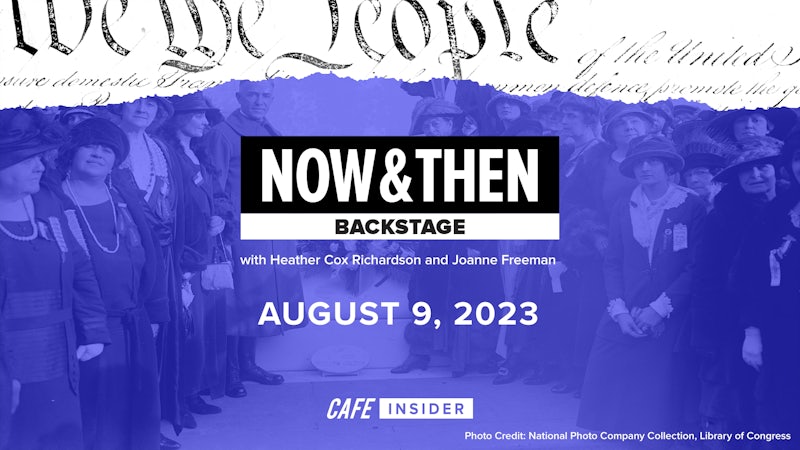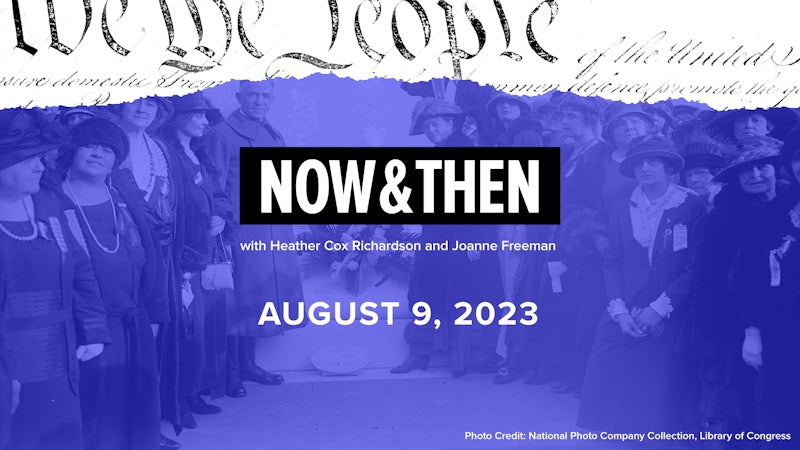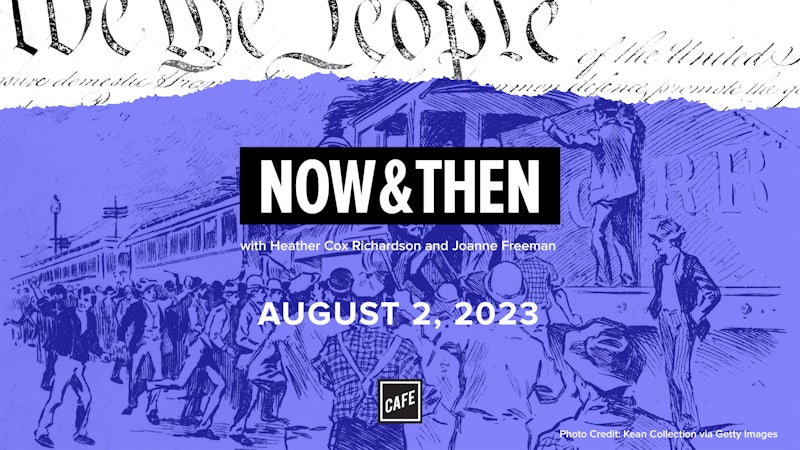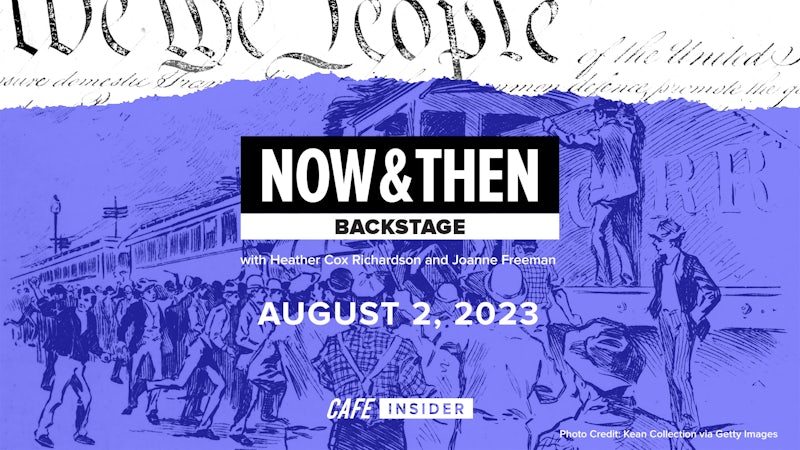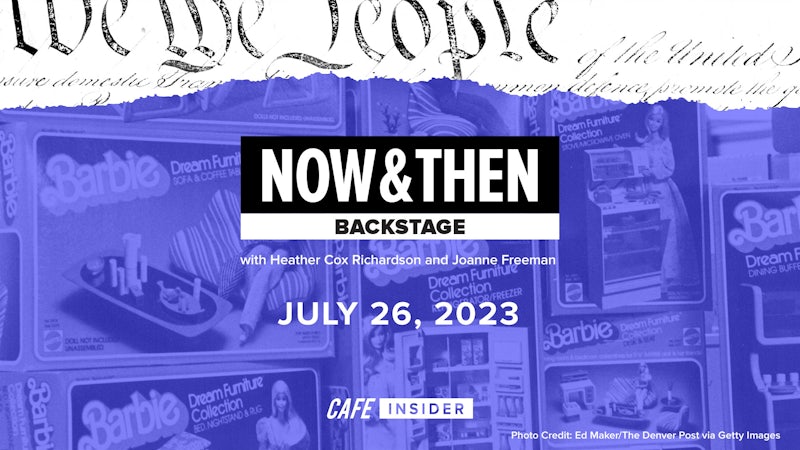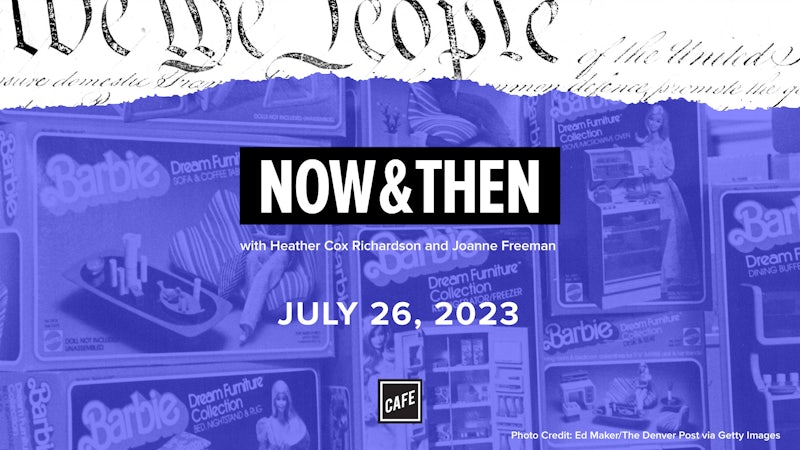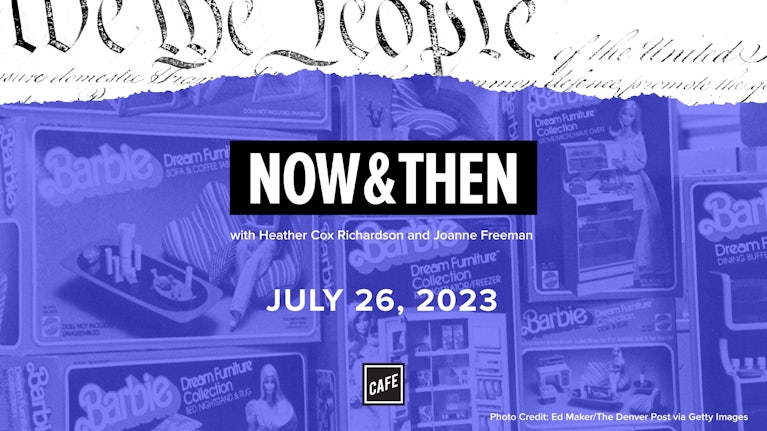Heather Cox Richardson:
From CAFE and the Vox Media Podcast Network, this is Now and Then. I’m Heather Cox Richardson.
Joanne Freeman:
And I’m Joanne Freeman. Today, we’re going to talk about a topic in a general way that is about big booms and busts, things that people invested in wildly, and then just as readily lost big amounts of money. And one of the things that led us into talking about this is something that I will readily acknowledge right here at the beginning of this episode. I read about it. I thought about it. I looked at preparatory materials, and I’m still vaguely confused. So I know I would wager there people out there who will agree with me in saying that NFTs, non-fungible tokens, that people are investing in, sometimes vast amounts of money, there have to be people that are as vaguely perplexed about this as I am. Heather is almost laughing because she saw me right before we began recording, looking both confused and bemused. But it was NFTs and the fact that there is cryptocurrency. All of this investment, and discussion, and excitement, and money, and potential, and possibilities and it’s the future. And I think that there’s a select group of people who understand really what they’re investing in.
Heather Cox Richardson:
And so many people who don’t. And I love the way that you put it that way, because you caught the excitement and the confusion. And what might this mean? And is it the wave of the future? Or is it a bubble? Is it real? Is it not? I think the whole concept of these is really, really interesting. I like all the themes. I don’t like the idea of participating in that particular world. But our producer described non fungible tokens to us as being essentially a deed. I think of them as like the Mona Lisa, it is a unique digital entity that stands by itself, rather as if you own the Mona Lisa and you can either license it or not, depending on the different NFT. So there’s sort of a digital asset and they live on a blockchain.
And the reason that I care at all about NFTs, really, although I think it’s a really interesting concept, is the idea of a blockchain, and that is the idea of essentially crowdsourcing digital history so that you could have something in the digital world that is secure, so that you can have the Mona Lisa without there being 3,000 or 300,000 copies of the Mona Lisa and you not knowing which is which. And it’s that whole idea that the history of that transaction and of every place that digital NFT has been is spread out over servers all over the world is what makes it able to have it be unique. So it’s both this idea of something being all your own, but it’s only all your own because it is recognized as all your own by everybody else, which I think is a really interesting concept.
Joanne Freeman:
So here’s an example of the sort of NFT that had vast money given to it, huge sums of money to purchase it, and then it lost, poof, all of that value in a very short amount of time. And this involves former Twitter CEO, Jack Dorsey, who sold an NFT of his first ever tweet, which he posted on Twitter’s launch day in March of 2006, which is actually remarkably not that long ago. He sold it, ingenious, and it sold it for nearly $3 million. He made the sale in March of 2021, but the current owner put it up for auction in April of this year. So that’s a little over a year later. And the highest bid was $280. So it sold for nearly 3 million-
Heather Cox Richardson:
Ouch.
Joanne Freeman:
Exactly. And the highest bid was $280. If that’s not boom and bust, I don’t know what is. And just the idea that someone came forward and was willing to pay $3 million for that is incredible. And the fact that within a year, that value disintegrated, that’s really remarkable. And it tells you something about the spirit and the motives of people investing in this kind of way.
Heather Cox Richardson:
It’s characteristic of a bubble, which is a period, an economic period in which values go up really high, and then they crash. They get very highly inflated and then they come down very quickly. And my favorite classic bubble, economists argue about whether or not this is actually true, but the most famous example of a speculative bubble is the Dutch tulip bulb craze, which was also known as tulip mania, which happened in the Dutch Republic during the 17th Century, when the prices for tulip bulbs started going up in about 1634 before they collapsed in 1637. And we tend to think of these extraordinary prices people were paying for tulip bulbs as an example of things that got highly overvalued. And economists look at that and often invoke that tulip mania as an example of the dangers of a free market. Other people say that the tulip bubble was not actually that significant for the finances of the Dutch Republic.
But I wanted to put that in there, because when last week there was a big crash in the value of certain cryptocurrencies, somebody wrote to me and said, “I do not understand why people keep doing this.” And I responded, “I have one word for you, tulips.” So it is kind of a theme. So that happened in Europe and these bubbles have been absolutely characteristic of America. And so you pulled out a great example of an early bubble that I had never heard about and is incredibly important, and I don’t understand at all.
Joanne Freeman:
It’s two different bubbles that kind of become one larger bubble, and for very logical reasons. So this all is dating to the very beginning of the United States, post-revolution and then in the 1790s. And what’s happening in that period are two things that really invite investment. On the one hand, you have states that are beginning to sell off frontier land in large quantities to make money because they’re desperate for money, which means that people are now speculating in land and buying potentially large suaves of land in the hope of selling them off into little pieces and making a vast fortune that way. So there is something that at some points is called land mania. Now independence has been declared and states are on their own that they’re now beginning to address questions like this, economic questions like this, but it continues on. The second thing that happens in this period that inspires that same kind of behavior is the creation of the Bank of the United States by Alexander Hamilton as part of his financial plan.
And the government is given control of a certain number of shares in the bank, and the rest of them are open for public purchase. And this, again, kind of like the land mania where people want to buy massive amounts and then sell them off and get rich quick, in a moment that, and this is worth noting, that they believe won’t happen again, beginning of the nation, huge amounts of land being sold off, capitalize on it now. The bank too. New bank just being brought into play, just becomes an institution, the very beginning of the sales of bank stock, and people go bonkers trying to buy and trade bank stock in massive quantities, investing huge amounts of money in the hope of essentially cornering the stock market even before it’s a full market. And one of the people who most famously does this is named William Duer, who for a time is the assistant secretary of the treasury. He’s actually a friend of Hamilton. So in a way he’s kind of a really early insider trader.
Heather Cox Richardson:
I was going to say, that sounds a little fishy.
Joanne Freeman:
Yeah. A little fishy. And he at various points asked for help from Hamilton who says, no. But at any rate, for a time he is assistant secretary of the treasury. He resigns from that post. And then once stock in the bank of the United States becomes available a few months after he resigns, he begins really speculating heavily on the rise and fall of Bank of the United States stock.
Heather Cox Richardson:
So basically they’re treating stock in the bank, which I assume is the paper of some sort, as if it were a stock. So you buy it low, you wait for it to go up, you sell it and you make bank off that.
Joanne Freeman:
It’s called script. So you, for $25, you get a certificate. July 1791 is when shares in the Bank of the United States begin to be sold. They’re $25 per share when it starts in July.
Heather Cox Richardson:
Which is a lot in those days, right?
Joanne Freeman:
Which is a lot. So in not a very long amount of time, it rises up to $250. So 10 times in New York, and in Philadelphia and in Boston, they’re selling these shares all over the place. Now, Jefferson, and Madison and others who were very suspicious about this speculation, if you look at Jefferson’s letters, he just thinks all of these money men, you can’t trust one of them, and whatever Hamilton’s done here, it’s fostering this corrupt and productionless, valueless kind of investment. He hates it. So for example, Jefferson writes to Madison in 1791 near the beginning of all of this and says, “it is impossible to say where the appetite for gambling will stop. The land office, the federal town, certain schemes of manufacture are all likely to be converted into element for that rage.”
He calls it scripomanie. It’s more commonly called scripomania, this wild selling of bank stock back and forth. And what Duer, William Duer, who’s doing this to a fault, ends up doing is buying and selling and buying and selling so fiercely that there’s a whole network of people bound up with him, who join him to invest, who he sells things to, who he owes money to. It becomes this enormous network of investment and debt. And ultimately it crashes. Duer does not manage his investments. Well, he crashes and he takes with him everyone who was alongside him in this investment. It’s a huge crash. It’s the financial panic of 1792 caused largely by William Duer. Just in New York City alone, it brings 25 investors to absolute ruin, puts Duer and a number of other very well to-do people in debtor’s prison. It causes a huge crash.
As Thomas Jefferson put it in kind of a zippy and also you can’t help but see that he’s kind of gleeful about the fact that the whole thing collapsed, he says, “the failure of Duer in New York soon brought on others, and these still more, like nine pins knocking one another down till at that place, New York, the bankruptcy has become general, every man concerned in paper being broke, and most of the tradesmen and farmers who had been laying by money, having been tempted by those speculators to lend it to them at an interest from 3 to 6% a month have lost the hole. It is computed. There is a dead loss at New York of about $5 million dollars, which is reckoned the value of all the buildings of the city, so that if the whole town had been burnt to the ground, it would’ve been just the measure of the present calamity supposing goods to have been saved.”
So that gives you a sense of what’s being talked about here. It’s massive, massive investment, and then just the total collapse of it that causes a widespread financial panic. It’s born of this sense that there’s kind of a once in a lifetime opportunity with something being born. Frontier lands now can be sold. New bank stocks being sold and you can afford them now, who knows in the future if they’ll be available. And if you can get these things, invest in them, speculate in them, wheel and deal and wheel and deal, you’re going to make a fortune, a vast amount of money. And so it’s people capitalizing on the moment in the hope basically of getting rich quick.
Heather Cox Richardson:
It seems to me like there is quite potentially a difference between the people who really thought they were buying up Pennsylvania land or Bank of the United States stock, who thought that they were investing in something real. And the people who were simply trying to say, I’m going to buy low and sell high. And what I really care about is basically fleecing other people. Is that true?
Joanne Freeman:
I think that is true. And I think in addition to that, there’s another level of people who are just being vaguely manipulated by the speculators. I’ll buy that note off of you. The government owes you money from the revolution, I’ll pay you for whatever on the dollar, 50 cents on the dollar and take that off of you. And so average Americans who do not have vast amounts of money to invest are also being swept up in this as well. So yeah, there are some people who are really investing in land. There are some people who just like the potential and the buying and selling and buying and selling. And then there are people who are kind of just caught up in that moment and are trying to make ends meet.
And it’s a moment you might not necessarily think of, is that when a nation kicks off in this way, suddenly there is a new national government and there are new national institutions, that there becomes a moment when it’s not entirely clear what can, or should, or will happen economically, and it makes perfect sense that there are people who are going to leap on that moment to see what they can get out of it.
Heather Cox Richardson:
Well, it’s also a question about values. What do you value? There’s things that really are valuable, like that Western land. There are things that can make you money, even though there’s not value, by outsmarting somebody else. And there’s also taking advantage of people, which are all three different things, and that are really interesting in that initial moment, like you say, because I would argue that the whole concept of a bubble in America, I don’t do other countries, is partly about the idea of possibility and anybody can do this if so long as they work hard enough. And there is an element, if you will, of the American dream in that. But there is also the flip side, the American con man, who’s like I can get something out of this myself so long as I can outsmart you.
Joanne Freeman:
I wouldn’t separate those two things necessarily. I mean, you talk about the American dream. And I think to some degree, the way in which people might see that kind of moment as a way to get to the American dream is built on a certain amount of mirage. It isn’t as though people have a clear plan, I will do X, Y and Z and gain P, D and Q, and then gain this amount of money. It’s a sort of spirit of the moment that seems like, to use your word, opportunity, but the opportunity is vague enough that it can be really more encouraging than it ought to be. And you’re right, that con men are a different entity in which they’re whole purpose is to just find ways to mislead people to get money.
But there’s an ambiguity there, even for people not trying to con other people, that is, I think part of these bubbles, is that they’re banked on possibility, and opportunity and a certain kind of a mirage, that not even necessarily if you work hard enough, but if you’re smart enough and you seize on the right opportunity at the right time in a nation that in some ways is distinctive because of its sort of early founding moments.
Heather Cox Richardson:
Yeah. But that contrasts with the next thing we wanted to talk about, which is kind of why I pushed you on that. And that’s the Yukon Gold Rush, because what’s in the gold rush at the end of the day is not gold for virtually anybody. But what is in it is an experience. And that’s going to play out differently than the collapse of 1792. But the end of the day there, the only real thing was the bank and the land. I mean, the real thing in the Yukon Gold Rush that people walk away with and that they remember very fondly for the most part, even though it’s not necessarily what really happened to them, is the experience of participating in a gold rush. I think that’s really important, because the people who participate in the gold rush did put effort into it. They did work really hard, and almost all of them ended up broke. But there are a lot more books saying, whoa, that was a great adventure, than there are books that said, man, I lost my shirt.
Joanne Freeman:
I think you’re totally right. The experience of it was important. But again, there’s that sort of mirage of money hovering over it, that, ooh, I’m going to do this. And you never know, I might really strike it rich, which weaves its way, I think through everything we’re talking about today.
Heather Cox Richardson:
I would say differently than, you never know, I might make it rich, you have, I’m smart enough, or I’m hardworking enough, or I’m whatever that I am going to be the one to strike it rich, even though the system itself is gamed against me. So the story of the Yukon Gold Rush is worth going into because it is so influential in our culture among other things. So the story behind it is that on August 16th, 1896, a couple of first nations men, a man named Keish and a man named Kaa, Keish was the uncle to Kaa, and they later get dubbed Skookum Jim Mason and Dawson Charlie, they find gold in the Klondike region of the Yukon in Northwestern, Canada, which is now on the border between Canada and Alaska. And they recognize that they had found gold, but they also recognized that as first nations or indigenous people, that their claim was going to get jumped and they wouldn’t be able to protect it.
So they get the brother-in-law to Keish, who is a white man named George Carmack, to file a claim on the land where they have found the gold. So a small village called Dawson City grows up around the area where they find the gold and they begin to prospect. Almost a year later in July of 1897, the strike begins. And it begins when a steamer sails into San Francisco to say there’s gold up in the Yukon. And the Portland reached Seattle. And that’s a really interesting moment, because these two ships carry between them gold dust and nuggets that are worth about $1.5 million and that way more than a ton. But this is actually the moment when Seattle becomes a real going concern. It had been a fishing port and a logging port before that. But the people who live in Seattle make a really big point of saying, this is where you can outfit for the Yukon.
And that’s really where we get Seattle as a major urban area or major city. You can still see in Seattle pieces of that early gold rush and the outfitting of the gold rush from there. Anyway, about 100,000 people moved from the lower 48 into the Yukon between 1896 and 1899. So in three years, 100,000 people. At the end of the day though, for all those people who gave up everything to go north, only about 30,000 of them actually ever got there. The trip was really treacherous. People had to go by foot over mountain passes in order to carry the enormous weight of the food and the supplies that the mounties required that they bring in. They often had to make as many as 40 round trips up into these passes. It broke an awful lot of people. Some people liked it. Some people sold out and went home.
And I pulled a list of some of the things that people carried with them as they went from Seattle up to the Yukon. One man carried a hand saw, two axes, two gold scales, he was hopeful, two butcher knives, a measuring tape, cartridge belts, towels, hatchets, planes, nails, rope, frying pans, spoons, knives, and forks, three suits of long underwear, three double breasted over shirts, a fur cap, two pairs of pants. I mean, and then for provisions, he brought 800 pounds of flour, 300 pounds of bacon, 20 pounds of evaporated onions, 50 pounds of evaporated apples, split peas, potatoes. And at the end of the day, he was carrying 2,327 pounds on his back up into those hills. But the point I was trying to make when we were talking about the collapse of 1792, is that a lot of these men, and women and children, by the way, who went up to Alaska, saw this as obviously a new frontier, but also sort of this profound adventure that was no longer available to them anywhere else.
And even if they were carrying almost 2,500 pounds of supplies, and even if they were suffering terrible frostbite, and even if they were going up Chilkoot Pass again, and again and again, they were living through something that was worth every moment of it. So Hamlin Garland, who is a novelist and a biographer, wrote about going up to Alaska, “I believed that I was about to take part in a most picturesque and impressive movement across the wilderness. I believed it to be the last great march of the kind which could never come in America so rapidly were the wild places being settled up. I wished therefore to take part in this tramp of the gold seekers, to be one of them and record their deeds. I wish to return to the wilderness also, to forget books, and theories of art and social problems, and come again face to face with the great free spaces of woods, and skies and streams. I willingly and with joy took the long way round, the hard way through.”
Joanne Freeman:
One of the things that’s part of that spirit, when I was digging around and finding out about the Yukon for this episode-
Heather Cox Richardson:
No pun intended.
Joanne Freeman:
I know. Well, am my digging? I need to say it, my digging turned up gold. A lot of people who ended up in the Yukon this way, didn’t ever really use their full name. Their identity from where they had come before was not part of what they brought with them, which is why we started out talking about Skookum Jim and Dawson Charlie, that these people would have names based on … There was lists actually of the names people got. Big Bill, because he was a tall guy so they called him Big Bill. Someone who, for some reason, they called Bam. I don’t know why. No one knew why. No one knew his name. There were all of these names of people, and they didn’t need more than that as far as their identity went. They were in that moment, taking part in this adventure. And again, in a more adventurous and spirited way, but the same kind of concept that something’s happening now, and it might not happen again and I want to be part of it.
In this case, really physically part of it. You can understand what drove people there, even though in the end, it was a very small, relatively small number of people who actually made money. I mean, I think it’s about 4,000 individual prospectors found gold, and a few hundred became truly wealthy, people who would’ve been known as the Klondike Kings. So vast numbers of people there going through this arduous trip with these massive amounts of supplies, a real trek, as Garland suggests, and in the end, seemingly happy to have taken part in it sort of buoyed along at the idea that they were going to make it. And in the end, the adventure was what they came away with.
Heather Cox Richardson:
There was real money to be made in the gold rush, but it was on supplying the miners. And one of my favorite stories about that is that’s where we get Nordstrom’s department store. That John Nordstrom was an immigrant who went up to the Yukon, finally found some gold on a claim after a couple years, I think it was. And then somebody said, no, no, no, no, that’s my claim. And Nordstrom let him buy him out for $13,000. He brought that back to Seattle and went into business with somebody where they supplied, can you guess? Can you guess what they supplied?
Joanne Freeman:
Duds? Clothing?
Heather Cox Richardson:
Shoes.
Joanne Freeman:
Oh, shoes. I was close.
Heather Cox Richardson:
They began as a shoe store.
Joanne Freeman:
When I visit family in Seattle, Nordstrom’s is sort of, ah, the shopping experience of Seattle more than any place else. Interesting.
Heather Cox Richardson:
But so this bubble is so crucially important, because while the money isn’t necessarily made there by the people who are supporting that bubble, it changes our culture.
Joanne Freeman:
It did shape our culture, just as you’re saying, Heather. And actually, there’s a ream of songs written about it. Some of them written clearly in the height of what was going on in the Yukon. Some that were sort of roughly written as it was heading into its downfall. And it’s one of the latter ones that I stumbled across and feel the need to offer here. Because a lot of the songs that I found were, marching to the Klondike. They were songs that you would expect people heading off to dig. This one was written in 1899, so it’s right at the end of the rush. And it was written by a San Francisco musician who went off to the Yukon, wanted to see what it was like, but it’s at the tail end of the whole rush.
And the name of it is On the Banks of the Yukon. (singing) There’s a river in Alaska called the Yukon, about which some fool off the wrote a song. But he surely must have been dreaming, or else his imagination proved him wrong. For the water in that river is so shallow, the fish stand on their heads to swim. The mosquitoes are so thick along the Yukon, you have to wear an armory of tin. That made me so happy when I found it. But that’s a parody and humorous, and showing someone who is reflecting on a moment that has passed.
Heather Cox Richardson:
Well, yes, but most of the songs about the Yukon and the stories of the Yukon lionize it, they celebrate it. The most famous of course is Jack London, who went up on the Alaska Gold Rush when he was 21, after dropping out of UC Berkeley as a student in order to go. He was a great writer, of course. And he wrote about that later on in a biographical piece that was published after he died in 1917, in which he said, “it was in the Klondike that I found myself. There, nobody talks. Everybody thinks. There, you get your perspective. I got mine.” And I think that there is a sense in that gold rush of it being a new place where people could figure out once again, what it meant to be American or what it meant to be a human being in a space that was not yet settled.
Jack London, when he was still alive in 1900 wrote about this. And he said, “the new Klondike, the Klondike of the future will represent remarkable contrasts with the Klondike of the past. Natural obstacles will be cleared away or surmounted, primitive methods abandoned, and hardship of toil and travel reduced to the smallest possible minimum. Exploration and transportation will be systematized. There will be no waste energy, no harum scarum carrying on of industry. The frontiersmen will yield to the laborer, the prospector to the mining engineer, the dog driver to the engine driver, the trader and speculator to the steady going modern man of business, for these are the men in his hands the destiny of the Klondike will be entrusted.”
And what he’s doing there is he’s talking about the change from this world, this new frontier. And I don’t mean that in the old Frederick Jackson Turner sense, but this new place where a man can be a man, and a man can work his way up and maybe be smarter or harder working than everybody else, to a much more systematized kind of economy where it matters that you have capital, and it matters that you have an education and all those things matter again.
Joanne Freeman:
If you say that the Yukon rush, one of the impacts of it is really cultural, that it creates this whole image. If you go back to the 1792 financial panic, the impact of that actually is the creation of the New York Stock Exchange. It is actually a response to that kind of wild mania climate. They institutionalize it. They create a climate where that can’t happen again. So in a sense, it’s very different from the Yukon, but there’s the same sense that institutions are closing in. There’s a forms and structures are closing in. And the ways in which you can adventure, and strike it rich and make yourself are vanishing.
Heather Cox Richardson:
And it’s so memorialized by people like Jack London in The Call of the Wild, for example, which a timeless book. And I have to say, people like Robert Service, the poet, the Canadian poet who left poem, after poem, after poem about life on the Yukon still exists in the popular memory and the popular mind. And I’m going to prove that to you. Look where I’m looking, Joanne. I’m looking right at you.
Joanne Freeman:
Yes.
Heather Cox Richardson:
There are strange things done in the midnight sun by the men who moil for gold, the Arctic trails have their secret tales that would make your blood run cold. The Northern Lights have seen queer sites, but the queerest they ever did see, was the night on the marge of Lake Lebarge I cremated Sam McGee. That poem goes on for page, after page, after page, after page. And it is popular enough that I know the entire thing. And I know two other people who also know the entire thing, and it gets recited in my household at least once every year.
Joanne Freeman:
What is the grip of that, that it has that pull?
Heather Cox Richardson:
It’s rollicking. It’s funny. It’s the story of a man from … Sam McGee was from Tennessee where the cotton blooms and grows, why he left his home in the South to roam round the pole, God only knows. It’s a story of this guy from Tennessee, who goes up to the Yukon to mine for gold and he is never warm. And I actually, I shouldn’t tell you how this turns out. It has a happy ending. Everybody should read that poem. It’s not just that it’s an easily rhymed rollicking poem that’s funny, that goes very well in front of a crowd. It’s also that it is very evocative of those kinds of rollicking stories that people would tell around a campfire.
Joanne Freeman:
Folklore. It’s American folklore.
Heather Cox Richardson:
Folklore, and also just sort of a, at a time when people were probably listening to radios and things were speeding up, this was very evocative of the image of an old world and an old comradery that I think still lives on.
Joanne Freeman:
In the music listening I was doing today, first I listened to music from the California Gold Rush and the 49ers. And those are sad songs. And for the most part, the songs from the Yukon are happy songs.
Heather Cox Richardson:
And it was brutal.
Joanne Freeman:
Right. No, it was brutal, but it’s striking. And the songs, there are a lot of songs in the Yukon about women, but it’s more like, I sure miss my woman. Whereas the 49ers, their women are dying.
Heather Cox Richardson:
Well, and that’s why I was talking earlier about value in bubbles, that this whole idea of the value of the gold and everybody was going to have a chance to get in and get rich quick. Those men and women for the most part did not leave with cash, but what they left with was something intangible, but nonetheless, something that most of them felt was overwhelmingly valuable, even if it wasn’t gold.
Joanne Freeman:
Which is interesting. I mean, I don’t think you’d say that about my cluster of guys in crash of 1792. They certainly had an image of themselves making it big and becoming a certain kind of man, with a certain kind of fortune, living a certain kind of life. But I don’t think the experience of that left them feeling very fond about it. The value of that first crash is monetary. The value of the second is part of what’s carrying people along.
Heather Cox Richardson:
Which brings something new to the whole idea of a boom and bust. And that is the dot com bubble of the 1990s, which I remember.
Joanne Freeman:
I had at least one student who took time off to go to California and try and start a dot com. Is that something that ever crossed your path?
Heather Cox Richardson:
I had a number of friends who started dot com businesses. And what was interesting about that is all of them failed except one, and that one became fabulously wealthy. Of course, everybody was inviting all of us to invest. And I was a graduate student, so I mean, I was investing in, I don’t know what, ramen noodles. So I wasn’t investing in anybody’s companies. But when they would tell me what their companies were doing, all of it sounded like, I don’t know, it might work, it might not. I got no idea. And it’s really interesting, the one who did the best is the one that I thought was a stupid idea, which is obviously why I should never invest in anything. And one of the ones that I thought was a really good idea did not do well.
Joanne Freeman:
What’s interesting about it is and what links it to some of what we’ve just said, the dot com boom and bust, is that sense, which is why I brought up my undergraduate who’s like, “I’m going to take a semester off and try and start a dot com with my friend,” is the sense that anybody could go, and invest and do anything, and there was no limits, because who knew what the internet could do and who knew what people would buy into? And there was that same kind of spirit of adventure, frontier spirit. And not only could you make it rich quick, but young people had an advantage because they were more familiar with the technology and more willing to undergo this kind of really starting right off the cuff, although these largely young men actually to go off and have this kind of adventure, similar in spirit.
And again, born of a moment between 1990 and 1997, so right when this is happening, the percentage of households in the United States that owned computers increased from 15% to 35%. So in that time period, more and more computers are in households. People are figuring out more and more what computers can do. And you have these people, just what you suggested, Heather, trying to figure out things that they can set in motion that other people are going to decide they need. And then they can get rich quick.
Heather Cox Richardson:
It’s like little kids with a toy. I mean, there’s all these studies that say, if you hand a kid a toy and tell him how to use it, he’ll just do it in that way. But if you hand a kid to someone and say, we don’t know what it does, she’ll think of 50,000 new things to do with it. And that’s kind of what it looked like. The dot com bubble comes out of the establishment of the NASDAQ Index in 1971. It’s dominated by technology. And that’s what we’re going to be looking at when we look at the dot com boom. So the first internet company that went public was Netscape. Remember Netscape? It was a browser. It began trading on the NASDAQ in August of 1995. During its first day of trading, the stock value doubled. Then Yahoo went public in August of 1996. And Amazon followed in 1997. And the gates were open. In 1999 alone, 24.1 billion with a B in public capital came out of 292 IPOs from these tech companies, and the value of equity markets grew exponentially during this period.
The NASDAQ rose from under 1,000 to more than 5,000 between 1995 and 2000. On March 10th, 2000, NASDAQ reached 5,132.52, and it would not get higher than that for another 15 years. Now, the night that it hit that peak, it happened at the PBS news hour had a panel. And on the panel was David Levy, who was an economic forecaster and vice chairman of the Jerome Levy Economics Institute at Bard College. And he said, “we got an issue here. The market is bound to fall because there is such a big gap between the stock price and the profitability of these companies.” That’s known as the price earnings ratio or the PE ratio when economists talk. He said-
David Levy (archival):
There’s always a healthy kind of speculation in the market and in the economy when people are taking risks in hoping that they’ll invest in something that will have productive returns. But when it gets to the point where people are investing simply because they think something will go up and they’ve stopped paying attention to the underlying value, in this case, the earnings of companies, or in the case of real estate in the 1980s, the rents that could be earned, it takes on an emotional, irrational character, which can go on for quite a while, but ultimately it’s found out that the emperor has no clothes.
Joanne Freeman:
Levy knew what he was talking about. The NASDAQ fell by more than 75% between March of 2000 and October of 2002, wiping out more than $5 trillion in market value. And even blue chip technology stocks, like Cisco, or Intel, or Oracle, lost more than 80% of their value. By early July 2000, at least 5,000 dot com workers, probably a lot more than that, at more than 70 companies had been fired. So there’s a network of layoffs having to do with the dot coms and everything that relied on them. The number of fired dot com workers was around 65,000 by May of 2001. Talk about boom and bust. That’s about as boomy and busty as you can imagine. Stock in Amazon fell from $89 a share at the pre burst peak on January 3rd, 2000, to $15.50 a share at the end of the year. What’s interesting about this is there were a handful, kind of like what you just said about the Yukon where there was a small number of people that actually came out of it making money, you can’t really say the same thing for 1792.
Here, there were a handful of companies, and Amazon is one and eBay is another, that conducted their affairs in a savvy way, invested in the right way and not in the wrong way. And in one way or another came out okay. Not a lot of them, but some of them came out okay. And obviously Amazon is the Amazon today. We know precisely what it is. So in a way, very similar along the lines of some of the other things we’ve been talking about, it becomes this swarm of people who all want to jump into that moment and see what they can get. And it’s an adventure and there’s a spirit. You get swept up in it and there’s no telling where you can go. And then in the end, there’s a handful of people, a small number of people who benefit. And in 1792, you get structure takes the place of the wild west of investment. You get the stock exchange. Here, you end up with these big companies that ultimately merge and connect with each other. America Online and Time Warner.
Joanne Freeman:
You again, get the sort of institutionalization of something that was kind of a wild west of investment early on. So in a way, these investors are accurate in saying that these moments seem like distinct moments where you have to plunge in and see where you can go and how high you can climb.
Heather Cox Richardson:
Well, and I love what Bezos said. After the stock collapsed with Amazon, he wrote a letter to his shareholders that said that the company was in great shape. And he ends up trying to have to grapple with the fact that the shares have dropped so much. And he says, “so if the company is better positioned today than it was a year ago, why is the stock price so much lower than it was a year ago?” And this is what I loved. “As the famed investor Benjamin Graham said, in the short term, the stock market is a voting machine. In the long term, it’s a weighing machine. Clearly there was a lot of voting going on in the boom year of ’99 and much less weighing. We’re a company that wants to be weighed, and over time we will be. Over the long term, all companies are. In the meantime, we have our heads down working to build a heavier and heavier company.”
And that idea of sort of, we need the froth, we need the foam at first to establish new companies, some of which are going to make it, really came through in an article in the New York Times by Aaron Griffith and Taylor Johnston called The Tech Bubble That Never Burst. Some investors believe market euphorias are a good, even necessary thing for progress. With all that attention and excitement, how can a startup founder convince workers and investors to help turn their crazy moonshot ideas into reality? Sure, most of the people who flock to a bubble are in it for the money. And yes, things can get messy. But underneath, it’s all moving forward. And that seemed to me to be a real larger look at the whole boom and bust and the pros and cons of it, the idea that we get new ideas, we get new enthusiasm. We get to redefine the American economy, and perhaps Americanism in a certain moment.
But I still come back to the idea that at the end of the day, the people who really walked away with something were the people in the gold rush, or perhaps some of those who tried to start something during the dot com bubble and came away at least with knowledge, with new ideas and perhaps parlayed that into something else. Then the people in 1792, who maybe had a great ride, but at the end of the day, did not have experiences or education to make up for the best part of their boom.
Joanne Freeman:
But think about that statement, which I love, that things can get messy, but underneath it’s all moving forward. What’s striking about that to me is we just spoke for almost an hour about individuals taking advantage of moments to get some kind of value, whether it’s the value of experience or the value of money. That that forward movement, that change over time, the change that is pushing things forward, it’s built on the individual striving, and ambitions and energies of all of these people we’ve been talking about today and all of the others that don’t have that kind of money to invest, but are all networked into the kinds of moments in time that drive these kinds of energies. So in a sense, we are all moving forward. Sometimes it’s built on the efforts and even the failures of some people, and we could have a whole different episode about capitalism for better and worse. But I love the idea that the same kind of mirage of money, and energies, and wishes and desires that push people forward in these efforts have an outcome that at least in part is progress.












